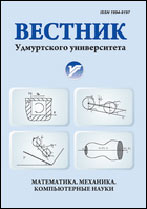|
This article is cited in 12 scientific papers (total in 12 papers)
MATHEMATICS
On the spectral set of a linear discrete system with stable Lyapunov exponents
I. N. Banshchikovaab, S. N. Popovaac
a Department of Differential Equations, Udmurt State University, ul. Universitetskaya, 1, Izhevsk, 426034, Russia
b Department of Higher Mathematics, Izhevsk State Agricultural Academy, ul. Studencheskaya, 11, Izhevsk, 426069, Russia
c Department of Dynamical Systems, N. N. Krasovskii Institute of Mathematics and Mechanics, Ural Branch of the Russian Academy of Sciences, ul. S. Kovalevskoi, 16, Yekaterinburg, 620990, Russia
Abstract:
Let us fix a certain class of perturbations of the coefficient matrix $A(\cdot)$ for a discrete time-varying linear system
$$
x(m+1)=A(m)x(m),\quad m\in\mathbb Z,\quad x\in\mathbb R^n,
$$
where $A(\cdot)$ is completely bounded on $\mathbb Z$, i.e., $\sup_{m\in\mathbb Z}(\|A(m)\|+\|A^{-1}(m)\|)<\infty$. The spectral set of this system, corresponding to a given class of perturbations, is a collection of all Lyapunov spectra (with multiplicities) for perturbed systems, when the perturbations range over this class all. The main attention is paid to the class $\mathcal R$ of perturbed systems
$$
y(m+1)=A(m)R(m)y(m),\quad m\in\mathbb Z,\quad y\in\mathbb R^n,
$$
where $R(\cdot)$ is completely bounded on $\mathbb Z$, as well as its subclasses $\mathcal R_\delta$, where $\sup_{m\in\mathbb Z}\|R(m)-E\|<\delta$, $\delta>0$. For an original system with stable Lyapunov exponents, we prove that the spectral set $\lambda(\mathcal R)$ of class $\mathcal R$ coincides with the set of all ordered ascending sets of $n$ numbers. Moreover, for any $\Delta> 0$ there exists an $\ell=\ell(\Delta)>0$ such that for any $\delta<\Delta$ the spectral set $\lambda(\mathcal R_{\ell\delta})$ contains the $\delta$-neighborhood of the Lyapunov spectrum of the unperturbed system.
Keywords:
discrete time-varying linear system, lyapunov exponents, perturbations of coefficients.
Received: 01.02.2016
Citation:
I. N. Banshchikova, S. N. Popova, “On the spectral set of a linear discrete system with stable Lyapunov exponents”, Vestn. Udmurtsk. Univ. Mat. Mekh. Komp. Nauki, 26:1 (2016), 15–26
Linking options:
https://www.mathnet.ru/eng/vuu515 https://www.mathnet.ru/eng/vuu/v26/i1/p15
|

| Statistics & downloads: |
| Abstract page: | 435 | | Full-text PDF : | 184 | | References: | 69 |
|



 Contact us:
Contact us: Terms of Use
Terms of Use
 Registration to the website
Registration to the website Logotypes
Logotypes